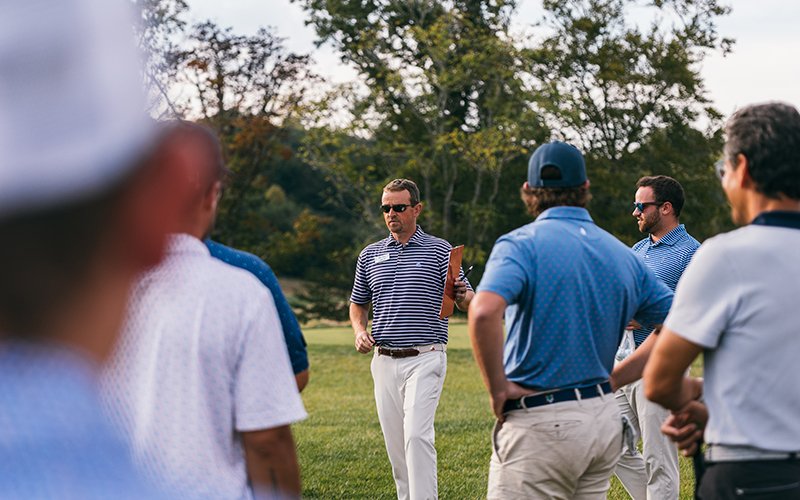When golfers decide to play in a charity golf tournament, they often reach out to their friends, family members, neighbors, or colleagues to fill their team. This is good news for your organization—not only does it fill your tournament’s field, but your mission gets exposure to a brand new audience of potential new donors and supporters.
Take full advantage of this opportunity to introduce your organization to a captive audience at your golf event. Create a cause connection by helping golfers understand what your organization does, who it serves, and how their participation is a key part of fulfilling your mission. They may have come to golf, but when they see the tangible impacts of what the tournament is raising money for, it’s easier to convert them into donors.
Here are 10 ideas for your next golf fundraiser to connect golfers to your mission:
1. Add compelling photos and videos to your event website.
A picture is truly worth a thousand words, so take advantage of your event website’s customization features to add photos that illustrate your organization’s work and impact. If possible, add video too—anything from a simple slideshow of photos set to music, an impact story, or a polished marketing video are effective in telling your organization’s story visually.
2. Invite a guest speaker to share their experience.
Kick off the tournament with a speaker who has benefited from your nonprofit’s services. Or add a presenter to a luncheon, banquet, or awards ceremony. Hearing first-hand from a beneficiary drives home the impact of your work. For example, Riverside Ranch, a therapeutic horse riding program, invited parents of riders to speak at their golf tournament’s luncheon and share what the Ranch meant to their family.
3. Include promo materials in player gift bags and golf carts.
A one-page flier, brochure, annual report, or other collateral can help golfers understand the depth of your mission. Be sure to include QR code on any printed materials with a direct link to the donation page on your event website where folks can donate right from their phones! Drop these in player gift bags or leave them in golf carts for golfers to peruse at their leisure. If your golf facility has carts with video capabilities, inquire about showing a video or photo slideshow on the screens. RiseUp Malawi, which provides educational opportunities in the African country of Malawi, played a video with a welcome message from some of the children the organization serves. They also provided each golfer with a book about Malawi with handwritten notes from the kids and on-site staff.
4. Place signage and banners around the golf course.
These pieces should be placed strategically around the course for maximum visibility. High traffic areas such as registration, driving range, putting green, and inside the clubhouse (near the bar or front door are good choices) are all guaranteed to get golfers looking. You can also place smaller signage unobtrusively on the golf course with information about your organization, facts related to your cause, or ways to take action. QR codes are a great addition to these as well to solicit donations.
National Ag Science Center placed banners around the golf course to help golfers better understand their mission.
5. Highlight your organization’s beneficiaries.
Depending on the work your nonprofit does, you could invite beneficiaries to attend or participate in the event. Personal connections are incredibly powerful, so provide opportunities for them to engage with golfers and sponsors throughout the day. For instance, if your golf tournament benefits a school, teachers or administrators could greet golfers as they arrive or even be added to teams. This isn’t limited to human beneficiaries, either! For example, pet rescue organizations could have adoptable pets at the golf course and an accompanying adoption drive.
6. Take advantage of downtime.
Downtime is a great chance to engage with a captive audience! Whether folks are waiting on the tee box, to check in, for a turn on the driving range, or for final results to be announced, your organization’s staff, board members, beneficiaries, or even volunteers can mingle with golfers to chat and have a conversation about your mission. You could also strategically station these folks on various tee boxes throughout the golf course (perhaps on a par 5 that might take groups longer to play through) to talk with golfers as they play their round or rethink your format to add in more opportunities for face time with participants. For example, Breckenridge Outdoor Education Center, an organization that removes barriers to outdoor experiences for those with special needs, used tee times rather than a traditional shotgun start to give them a few minutes to visit with each group as they waited for their turn to tee off.
7. Hold an accompanying event.
If it makes sense for your organization, hold an event in conjunction with your golf fundraiser that drives home your mission. Outlook Enrichment, a nonprofit that serves the visually-impaired, holds a blind golfers clinic alongside its annual charity golf tournament. The clinic features instructors and volunteers helping visually-impaired golfers putt, chip, and play a few holes. Many organizations also hold events targeting non-golfers, such as golf lessons, a wine tasting, blanket-tying or meal-packing event.
A volunteer coach helps a participant line up their shot during Outlook Enrichment’s blind golfers clinic.
8. Send push notifications.
Your golf event management platform should be able to send push notifications to golfers via a mobile app for easy communication. These notifications can help connect golfers to your mission by including a link to your website, testimonials from beneficiaries or volunteers, or even solicit donations for a specific program or outreach effort. Keep the notifications short, impactful, and time them strategically.
9. Display photos or memorabilia on the course.
Golfers want to know what the tournament is raising money for—what better way than to display photos or related memorabilia on the golf course. For instance, the Pat Neal Memorial Golf Tournament raises money for brain cancer research in honor of the tournament’s namesake, Pat Neal. A photo of Pat was placed on the course and golfers were encouraged to sign the photo as a keepsake for Pat’s family.
10. Provide opportunities to take action.
The ultimate goal of helping golfers understand your mission is to have them take some sort of action, so give them the opportunity to do so. You could set up a donation station where folks can contribute, solicit volunteer sign ups, have a pop up shop to sell branded merchandise or products, or let folks start the process of adopting a pet.
Wrapping Up
First and foremost, technology is a major asset in creating cause connection. From your event website to push notifications to impact videos, leverage tech tools to be effective (and make it easier). Use tech to tell your organization’s story; engage with golfers before, during, and after the tournament; and ultimately, compel golfers and sponsors to further support it through a donation or future events. In doing so, you can demonstrate the impact your organization has on your community at large.
Get Qualified for No-Cost Event Technology
GolfStatus’ Golf for Good program gives back to nonprofits by providing access to its full golf event management and fundraising platform at no cost, so event planners can focus on building relationships, stewarding donors, and doing more good. Get qualified by clicking the button below!









































